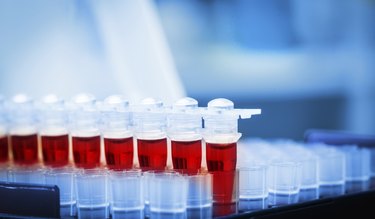
In the United States, blood glucose readings are usually expressed in units of milligrams of glucose per deciliter of blood, or mg/dL. Internationally and in scientific journals, blood glucose is typically expressed in millimoles per liter, or mmol/L. The same way you can convert your weight in kilograms to pounds, you can easily convert your blood glucose values from mmol/L to mg/dL. Both systems are equally precise.
Doing the Calculation
Video of the Day
The easiest way to convert blood glucose from mmol/L to mg/dL is to multiply the value in mmol/L by 18 and change the units. For example, if your reading is 12 mmol/L, you multiply 12 mmol/L by 18, which equals 216, and change the units to mg/dL: 216 mg/dL. The number 18 represents the conversion factor, which relates to the molecular structure and weight of glucose.
Video of the Day
Comparing Blood Glucose Values
When you look at blood glucose values represented in mg/dL, the numbers are much greater than the values expressed in mmol/L. This can lead to confusion, especially if you overlook the units. Knowing a few values in both systems can help you get used to how they compare. For instance, a blood glucose of 100 mg/dL is 5.5mmol/L, 200mg/dL is 11.1 mmol/L and 300 mg/dL is 16.6 mmol/L.
Other Choices in Conversion
Many blood glucose meters allow the user to change the units from mmol/L to mg/dL by changing the settings as described in the instruction booklet. Online calculators can also do the job for you. If Internet access is a problem, you can print out a conversion table and keep it handy.
Is this an emergency? If you are experiencing serious medical symptoms, please see the National Library of Medicine’s list of signs you need emergency medical attention or call 911.